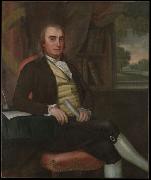
Oil On
Canvas, Real Flavor of Old Masters
|
Ralph Earl
|
|||
|
|
|||
| 1751- 1801 Ralph Earl Galleries Ralph Earl was born in either Shrewsbury or Leicester, Massachusetts. By 1774, he was working in New Haven, Connecticut as a portrait painter. In the autumn of 1774, Earl returned to Leicester, Massachusetts to marry his cousin, Sarah Gates. A few months later, their daughter was born; however, Earl left them both with Sarah's parents and returned to New Haven. Like so many of the colonial craftsmen, Earl was self-taught, and for many years was an itinerant painter. In 1775, Earl visited Lexington and Concord, which were the sites of recent battles in the American Revolution. Together with engraver Amos Doolittle, he painted four of his most famous pictures, all battle scenes. Although his father was a colonel in the Revolutionary army, Ralph Earl himself was a Loyalist. In 1778, he left behind his wife and daughter and escaped to England by disguising himself as the servant of British army captain John Money. | |||
|
|
|||
|
|
John Davenport new24/Ralph Earl-739365.jpg Painting ID:: 72885 Visit European Gallery |
"John Davenport (1750-1830), B.A. 1770, M.A. 1773," oil on canvas, by the American artist Ralph Earl. 47 7/8 in. x 40 in. Gift of Miss Harriett C. Davenport to Davenport College, Yale. Courtesy of the Yale University Art Gallery, Yale University, New Haven, Conn. cjr | |
Height Width |
INS/CM |
||
|
X |
|
||
|
|
|||







